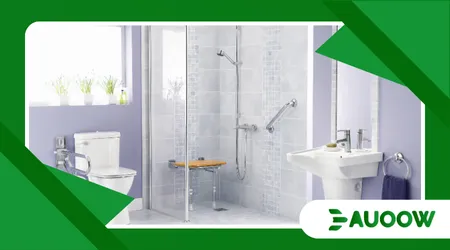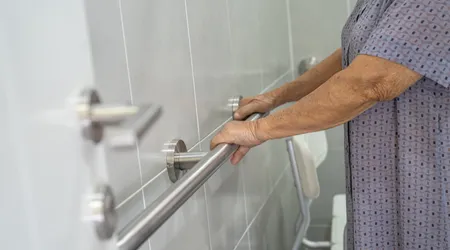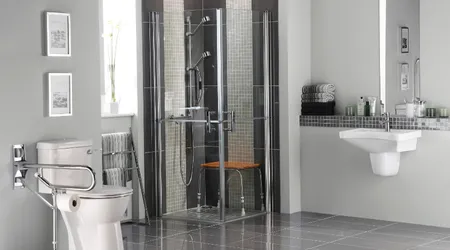How to Make Shared Bathrooms Accessible Without Major Renovations

To make shared bathrooms accessible is a pressing need in 2025, as inclusive spaces gain priority. Public and workplace bathrooms often serve diverse users, yet many lack accommodations for people with disabilities, elderly individuals, or families with young children.
Accessibility isn’t just about compliance it’s about dignity, independence, and equity. Retrofitting shared bathrooms without costly renovations is achievable with strategic, practical solutions.
This article explores innovative, budget-friendly ways to enhance accessibility, drawing from real-world examples, current standards, and actionable insights to create welcoming spaces for all.
Why does accessibility matter? Beyond legal mandates, it’s about ensuring everyone can use a facility comfortably.
The U.S. Census Bureau notes that 13% of Americans live with a disability, a figure likely higher globally when including temporary impairments.
Shared bathrooms, found in offices, schools, or community centers, often lag in inclusive design. Major renovations like widening doorways or installing new plumbing can be expensive and disruptive.
Instead, low-cost, high-impact changes can transform these spaces. From grab bars to signage, this guide offers creative solutions grounded in real needs and practical applications.
Understanding Accessibility Needs in Shared Bathrooms
Accessibility in shared bathrooms means addressing mobility, sensory, and cognitive challenges. People using wheelchairs need space to maneuver; visually impaired individuals require tactile cues.
Cognitive disabilities may call for clear signage. To make shared bathrooms accessible, start by assessing user needs.
For example, a small office bathroom may need grab bars for elderly employees, while a school might prioritize family-friendly features like changing tables.
Consider the story of a community center in Seattle that upgraded its bathroom in 2024. Without tearing down walls, they added modular grab bars and lowered mirrors.
This simple fix empowered wheelchair users and seniors. Needs vary, so engage users ask what barriers they face.
++ Is Your Neighborhood Walkable for People with Disabilities?
A 2023 study by the National Institute on Disability found 68% of disabled individuals avoid public restrooms due to inaccessibility. Listening to users ensures solutions are practical and impactful.
Another angle is universal design, which benefits everyone. A parent with a stroller and a wheelchair user both need wider pathways.
To make shared bathrooms accessible, think inclusively solutions like lever faucets help those with arthritis and young children alike.
Conduct a walkthrough with diverse users to identify pain points, like high sinks or cluttered layouts. Small tweaks can yield big results without breaking the bank.

Practical Modifications for Mobility and Safety
Mobility challenges demand thoughtful adjustments in shared bathrooms. Installing grab bars near toilets and sinks is a game-changer.
These can be mounted without structural changes, using sturdy wall anchors. For example, a Chicago library added foldable grab bars in 2024, costing under $500, enhancing safety for seniors and disabled patrons.
Clear floor space is critical. Remove unnecessary fixtures like decorative plants to create turning space for wheelchairs 36 inches minimum, per ADA guidelines.
To make shared bathrooms accessible, rearrange layouts creatively. A café in London swapped out bulky trash cans for slim, wall-mounted ones, freeing up floor space. This cost $200 but made the bathroom navigable for wheelchair users.
Also read: The Truth About “Accessible” Airbnbs: What to Look For
Non-slip mats are another low-cost fix. Wet floors are a hazard for everyone, especially those with mobility aids.
Peel-and-stick mats with textured surfaces can be installed in hours. Pair these with adjustable-height showerheads for seated users. These small changes, often under $100, boost safety and independence without major overhauls.
Enhancing Sensory and Cognitive Accessibility
Sensory and cognitive accessibility often gets overlooked. For visually impaired users, high-contrast signage and Braille are essential.
To make shared bathrooms accessible, add tactile markers on door handles and faucets. A 2025 initiative in Toronto’s public libraries introduced Braille labels on stalls, costing $300, improving navigation for blind patrons.
Lighting matters too. Harsh fluorescents can disorient those with sensory sensitivities. Swap bulbs for softer, warm-toned LEDs around $50 per bathroom.
Read more: How to Make a Shared Kitchen Accessible for Multiple Needs
For cognitive accessibility, use clear, icon-based signage. A school in Austin added pictograms for “toilet” and “sink” in 2024, aiding neurodivergent students. These signs cost $150 but made the space intuitive.
Sound can be a barrier. Echoey bathrooms confuse those with hearing impairments. Acoustic panels, priced at $200, can dampen noise.
To make shared bathrooms accessible, think beyond physical barriers sensory and cognitive tweaks create truly inclusive spaces. Test changes with user feedback to ensure they work.
Family-Friendly and Inclusive Features
Shared bathrooms must serve families too. Baby changing stations are a must but don’t require renovations. Wall-mounted, foldable units cost $200-$400 and install quickly.
A mall in Miami added these in 2024, boosting parent satisfaction. To make shared bathrooms accessible, consider all users parents, caregivers, and children benefit from such additions.
Gender-neutral options are increasingly vital. Converting single-stall bathrooms to all-gender use costs nothing but a sign change around $50.
A university in Boston did this in 2025, promoting inclusivity. Companion care stalls, with extra space for caregivers, can be created by removing a partition, as seen in a New York community center.
Small touches like step stools for children or shorter users enhance usability. These cost $20-$50 and store easily. Imagine a bathroom as a Swiss Army knife versatile, compact, and functional for all.
To make shared bathrooms accessible, prioritize features that serve diverse needs without structural changes.
Leveraging Technology for Accessibility
Technology offers clever solutions for accessibility. Motion-sensor faucets and soap dispensers, priced at $100-$300, aid those with limited dexterity.
A co-working space in Denver installed these in 2024, improving hygiene and ease of use. Smart mirrors with adjustable lighting can help visually impaired users, costing $400 but installable without plumbing changes.
Voice-activated controls are emerging in 2025. A hospital in San Francisco tested voice-activated flush valves, costing $500 per unit, benefiting wheelchair users.
Apps like AccessNow map accessible bathrooms, guiding users to upgraded facilities. Technology isn’t a full fix but amplifies other efforts, making bathrooms more inclusive.
Cost is a concern, but many tech upgrades are one-time investments. Grants, like those from the U.S. Access Board, can offset expenses.
Explore local funding for accessibility projects. Technology, paired with physical tweaks, creates a seamless user experience without gutting the space.
Cost and Implementation Table
| Modification | Estimated Cost | Installation Time | Accessibility Benefit |
|---|---|---|---|
| Grab Bars | $100-$500 | 1-2 hours | Mobility support for seniors, disabled |
| Non-slip Mats | $50-$100 | 1 hour | Safety for all users |
| Braille Signage | $150-$300 | 1-2 hours | Navigation for visually impaired |
| Baby Changing Station | $200-$400 | 2-3 hours | Family-friendly functionality |
| Motion-Sensor Faucets | $100-$300 | 3-4 hours | Ease for limited dexterity |
Maintaining and Monitoring Accessibility
Upgrades are only effective if maintained. Regular checks ensure grab bars stay secure and signage remains clear.
A 2024 case in a Minneapolis office showed neglected grab bars caused injuries, undermining trust. Assign staff to monthly inspections simple but vital.
User feedback is gold. Create a suggestion box or digital form for input. A community center in Atlanta used feedback to adjust sink heights in 2025, costing $200 but boosting usability. Accessibility isn’t static; needs evolve, so stay responsive.
Training staff on accessibility fosters inclusivity. Teach them to assist without assuming needs.
A café in Sydney trained baristas to guide visually impaired patrons to bathrooms, enhancing the experience. Maintenance and engagement ensure long-term success.
Overcoming Common Challenges

Budget constraints are real. Prioritize high-impact, low-cost fixes like grab bars over pricier tech. A small business in Portland stretched $1,000 to add mats, signage, and stools in 2024. Start small, scale up with grants or donations.
Space limitations can frustrate efforts. Use foldable fixtures to maximize room. A gym in Chicago installed collapsible changing tables, saving space.
Resistance from stakeholders? Highlight benefits like increased foot traffic accessible spaces attract diverse users.
Time is another hurdle. Many fixes take hours, not days. A school in Dallas added grab bars over a weekend, minimizing disruption. Address challenges with creativity and user-focused planning to keep projects on track.
Conclusion
Creating accessible shared bathrooms without major renovations is not just possible it’s essential. By prioritizing user needs, leveraging low-cost solutions, and embracing technology, facilities can become inclusive havens.
From grab bars to Braille, small changes yield big impacts. Why settle for exclusion when inclusion is within reach?
In 2025, accessibility is a commitment to dignity for all. Engage users, monitor progress, and adapt. Start today every step forward makes a difference.
Frequently Asked Questions
Q: Can small businesses afford to make shared bathrooms accessible?
A: Yes, many solutions like grab bars or signage cost under $500 and qualify for grants.
Q: How long do accessibility upgrades take?
A: Most, like mats or Braille signs, take 1-4 hours, minimizing disruption.
Q: Do these changes comply with ADA standards?
A: Many align with ADA, but consult local codes or experts to ensure compliance.
Q: How can I get user feedback on bathroom accessibility?
A: Use suggestion boxes, digital surveys, or host focus groups with diverse users.
